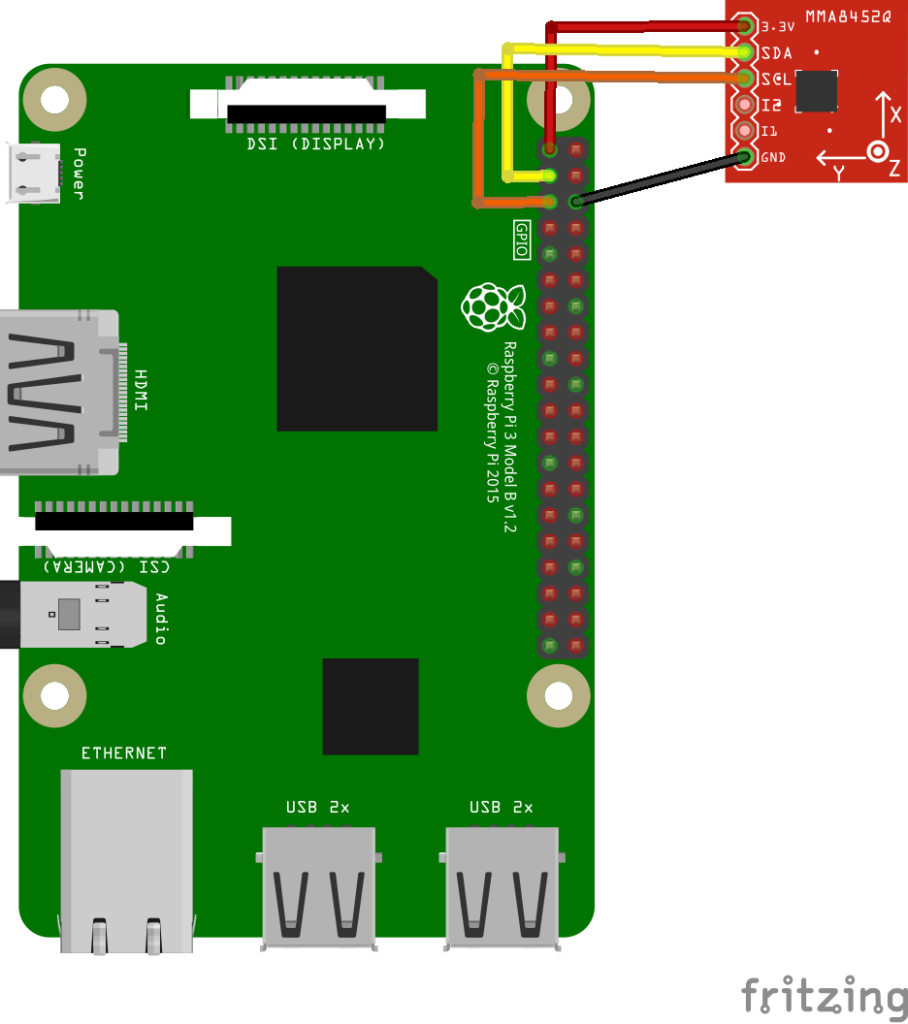In this example we will connect a MMA8452Q accelerometer to a Raspberry Pi
Lets look at some information about the sensor
The MMA8452Q is a smart, low-power, three-axis, capacitive, micromachined accelerometer with 12 bits of resolution. This accelerometer is packed with embedded functions with flexible user programmable options, configurable to two interrupt pins. Embedded interrupt functions allow for overall power savings relieving the host processor from continuously polling data.
The MMA8452Q has user selectable full scales of ±2 g/±4 g/±8 g with high-pass filtered data as well as non-filtered data available real-time. The device can be configured to generate inertial wakeup interrupt signals from any combination of the configurable embedded functions allowing the MMA8452Q to monitor events and remain in a low-power mode during periods of inactivity
Features
• 1.95 V to 3.6 V supply voltage
• 1.6 V to 3.6 V interface voltage
• ±2 g/±4 g/±8 g dynamically selectable full-scale
• Output data rates (ODR) from 1.56 Hz to 800 Hz
• 99 μg/√Hz noise
• 12-bit and 8-bit digital output
• I2C digital output interface
• Two programmable interrupt pins for six interrupt sources
• Three embedded channels of motion detection
— Freefall or motion detection: one channel
— Pulse detection: one channel
— Transient detection: one channel
• Orientation (portrait/landscape) detection with set hysteresis
• Automatic ODR change for auto-wake and return to sleep
• High-pass filter data available real-time
• Current consumption: 6 μA to 165 μA
Connection
Here is a layout, its an easy device to connect, this is a Raspberry Pi 3. You can use other variants of the hardware as well.
Parts List
Here are the parts I used
Code
As you can see this is a controleverything example called MMA8452.c
[codesyntax lang=”cpp”]
#include <stdio.h>
#include <stdlib.h>
#include <linux/i2c-dev.h>
#include <sys/ioctl.h>
#include <fcntl.h>
void main()
{
// Create I2C bus
int file;
char *bus = "/dev/i2c-1";
if((file = open(bus, O_RDWR)) < 0)
{
printf("Failed to open the bus. \n");
exit(1);
}
// Get I2C device, MMA8452Q I2C address is 0x1C(28)
ioctl(file, I2C_SLAVE, 0x1C);
// Select mode register(0x2A)
// Standby mode(0x00)
char config[2] = {0};
config[0] = 0x2A;
config[1] = 0x00;
write(file, config, 2);
// Select mode register(0x2A)
// Active mode(0x01)
config[0] = 0x2A;
config[1] = 0x01;
write(file, config, 2);
// Select configuration register(0x0E)
// Set range to +/- 2g(0x00)
config[0] = 0x0E;
config[1] = 0x00;
write(file, config, 2);
sleep(0.5);
// Read 7 bytes of data(0x00)
// staus, xAccl msb, xAccl lsb, yAccl msb, yAccl lsb, zAccl msb, zAccl lsb
char reg[1] = {0x00};
write(file, reg, 1);
char data[7] = {0};
if(read(file, data, 7) != 7)
{
printf("Error : Input/Output error \n");
}
else
{
// Convert the data to 12-bits
int xAccl = ((data[1] * 256) + data[2]) / 16;
if(xAccl > 2047)
{
xAccl -= 4096;
}
int yAccl = ((data[3] * 256) + data[4]) / 16;
if(yAccl > 2047)
{
yAccl -= 4096;
}
int zAccl = ((data[5] * 256) + data[6]) / 16;
if(zAccl > 2047)
{
zAccl -= 4096;
}
// Output data to screen
printf("Acceleration in X-Axis : %d \n", xAccl);
printf("Acceleration in Y-Axis : %d \n", yAccl);
printf("Acceleration in Z-Axis : %d \n", zAccl);
}
}
[/codesyntax]
Output
Compile the c program.
$>gcc MMA8452Q.c -o MMA8452Q
Run the c program.
$>./MMA8452Q
This is what you should see
Links
https://www.nxp.com/docs/en/data-sheet/MMA8452Q.pdf



